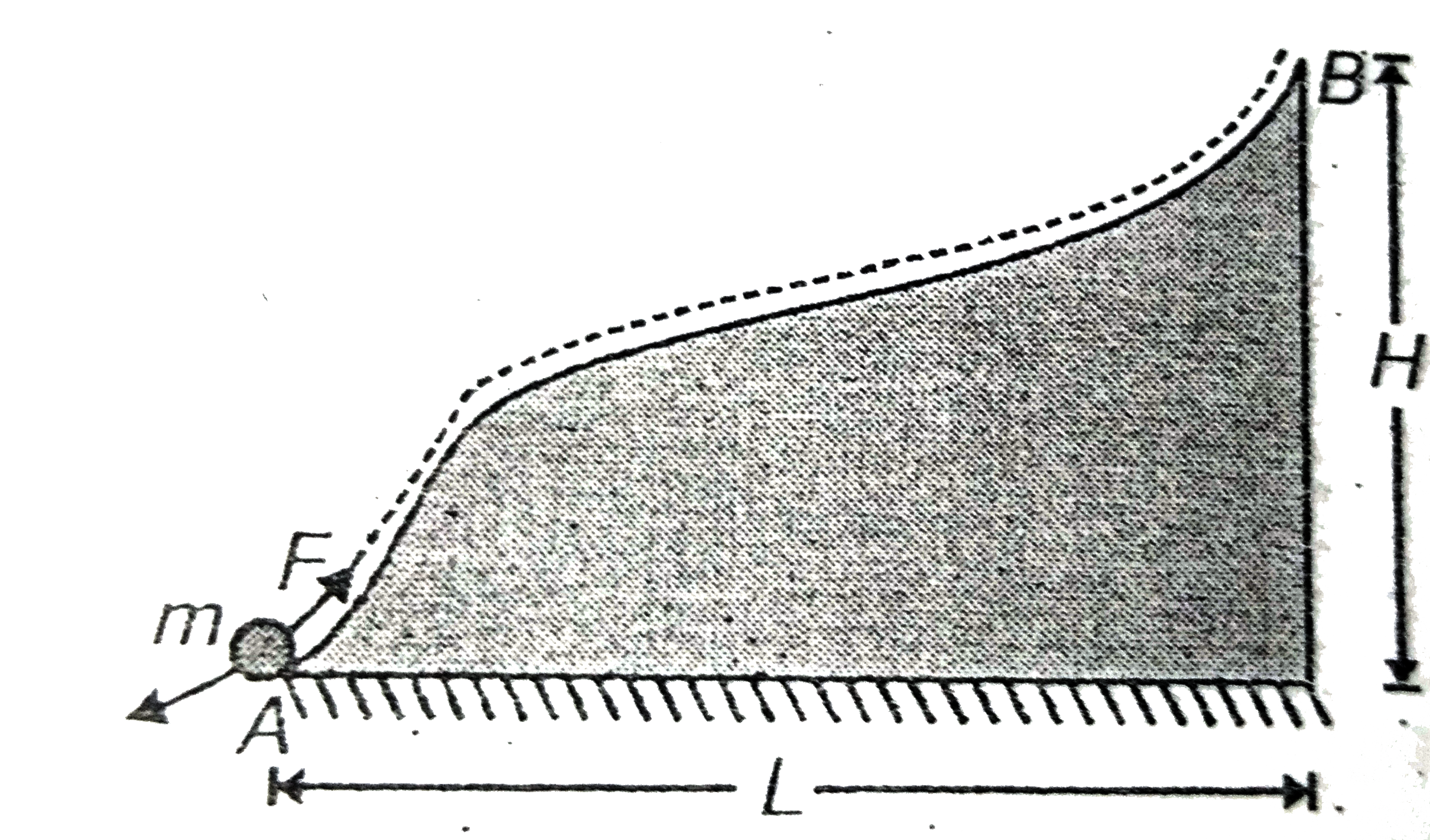An object of mass m slides down a hill of height h and of arbitrary shape and stops at the bottom because of friction. The coefficient of friction may be different for different segments of the path. Work required to return the object to its position along the same path by a tangential force is
mgh
2mgh
=−mgh
it can not be calculated
The correct Answer is:B
Step by step video, text & image solution for An object of mass m slides down a hill of height h and of arbitrary shape and stops at the bottom because of friction. The coefficient of friction may be different for different segments of the path. Work required to return the object to its position along the same path by a tangential force is by Physics experts to help you in doubts & scoring excellent marks in Class 11 exams.
Topper's Solved these Questions
Similar Questions
How much energy will be needed for a body of mass 100kg to escape from the earth- (G=10M/S2 and radius of earth = 6.4 xx 10^(6) m)
03:49View SolutionAn object of mass m slides down a hill of arbitrary shape and after travelling a certain horizontal path stops because of friction. The total vertical height descended is h. The friction coefficient is different for different segments for the entire path but is independent of the velocity and direction of motion. The work that a tangerial force must perform to return the object to its initial position along the same path is
07:00View SolutionA body of mass m was slowly hauled up the hill (figure) by a force F which at each point was directed along a tangent to the trajectory. Find the work performed by this force, if the height of the hill is h, the length of its base l, and the coefficient of friction k.
 08:38View Solution
08:38View SolutionWhen an object slides along a rough siuface, the force of friction does negative work on it. Is it ever possible for friction to do positive work? Give an example.
04:23View SolutionA small object of mass 'm' is moved over a rough, curved surface as shown. The force which moves it along the dotted path shown is always tangential to the curved path. If the object moves with negligible speed, find the work done by the force F in moving it from A to B. The coefficient of friction between the object and the curved surface is μ.
 05:42View Solution
05:42View SolutionConsider a block of mass m that slides down the different inclined planes having same base legth L and same coefficient of friction. STATEMENT-1 Work done by force of friction will be same for the motion of the two inclined planes. STATEMENT-2 Frictional force is a conservation force.
03:15View Solutionएक पहाड़ी पर 54km/h की चाल से ऊपर की ओर जाती हुई एक कार का इंजन बंद कर दिया जाता हैं और वह पहाड़ी पर 10m ऊँचाई (दूरी नहीं ) तक जाकर रुक जाती हैं । कार का द्रव्यमान 1400 kg मानते हुए घर्षण बल के विरुध्द किए गए कार्य की गणना कीजिए (घर्षण व्दारा किए गए कार्य का ऋणात्मक ) ।
04:57View SolutionConsider a frictionless rampp on which a smooth object is made to slide down from an initial height h . The distance d necessary to stop the object on a flat track ( of coefficient of friction μ ) , kept at the ramp end is
04:57View SolutionConsider a frictionless rampp on which a smooth object is made to slide down from an initial height h . The distance d necessary to stop the object on a flat track ( of coefficient of friction μ ) , kept at the ramp end is
View Solutionএকটি মসৃন নততল বেয়ে m ভরের একটি বস্তু hউচ্চতা থেকে ভূমিতে আসে পরে একটি অমসৃণ অনুভূমিক তলে ( ঘর্ষণ গুণাঙ্ক =μ)গিয়ে পড়ে। ওই তলে কত দূর গিয়ে বস্তুটি থেমে যাবে ?
 08:18View Solution
08:18View SolutionBy application of a force F , a body of mass m is raised to the top of a hill .F is tangential along the whole path. If the height of the hill is h, the length of the base of the hill is l , and the coefficient of friction is μ , then find the work done.
View SolutionConsider a frictionless ramp on which a smooth object is made to slide down from an initial height 'h'. The distance 'd' necessary to stop the object on a flat track of coefficient of friction 'μ.'), kept at the ramp end is
View SolutionConsider a frictionless ramp on which a smooth object is made to slide down an initial height 'h'. The distance 'd' necessary to stop the object on a flat track (of coefficient of friction 'μ'), kept at the ramp end is
02:48View SolutionAn object of mass m slides down a hill of arbitrary shape and after travelling a certain horizontal path stops because of friction. The total vertical height descended is h. The friction coefficient is different for different segments for the entire path but is independent of the velocity and direction of motion. The work that a tangerial force must perform to return the object to its initial position along the same path is
View Solutionm द्रव्यमान की एक वस्तु को धीरे-धीरे चित्र में दर्शाई गई पहाड़ी पर F बल के द्वारा गति कराई जाती है, बल F प्रत्येक बिन्दु पर पथ की स्पर्श रेखा के अनुदिश लगता है। इस बल द्वारा किया गया कार्य ज्ञात कीजिए, यदि पहाड़ी की ऊँचाई h है आधार की लम्बाई l व घर्षण गुणांक k है।
 09:58View Solution
09:58View Solution

